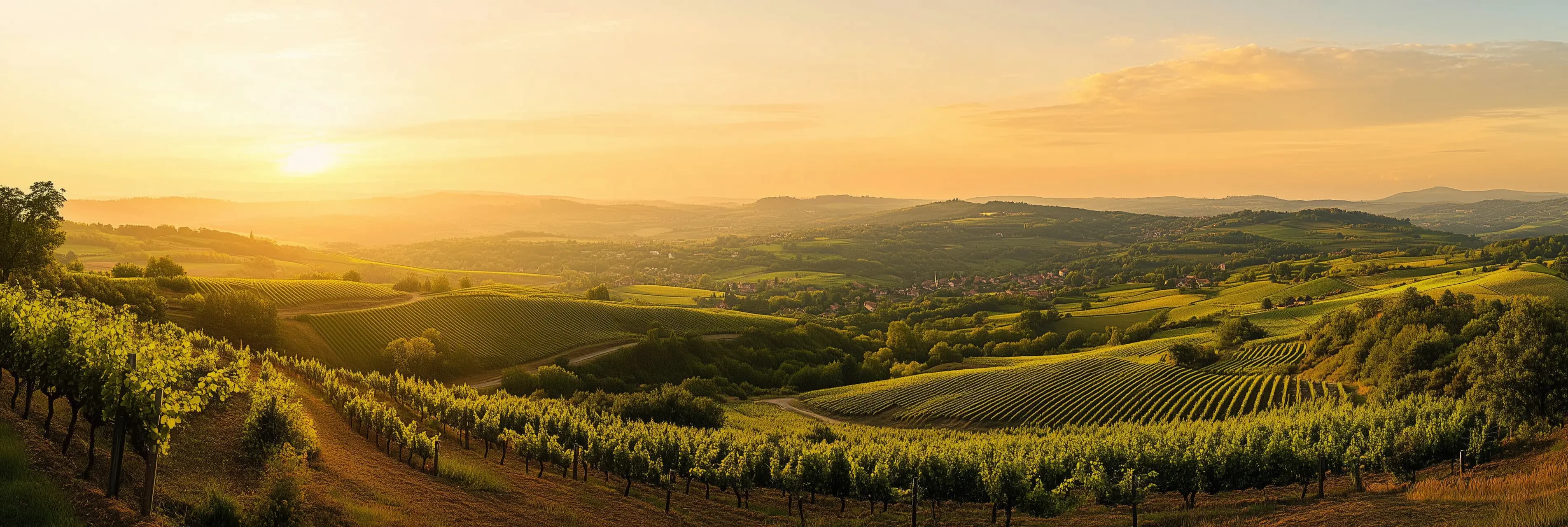Beaujolais and the Rhône: a river’s role in wine trade history
In the world of French wines, Beaujolais has carved a unique identity with its vibrant Gamay wines and charming Crus. However, behind the success of this renowned region lies a vital natural ally that has played an essential role for centuries: the Rhône River. This great waterway served as a commercial artery, influencing the trade, culture, and even the evolution of winemaking in Beaujolais. Let’s delve into how the Rhône shaped the Beaujolais wine trade and why its influence remains evident to this day.
Connecting North and South
The Rhône River, one of Europe’s longest waterways, flows over 800 kilometers from the Swiss Alps to the Mediterranean Sea.
For Beaujolais, located to the west of the river, this proximity offered a direct route to the cities of Lyon, Provence, and beyond. Before the advent of rail transport, the Rhône served as a natural conduit for goods, making it possible for Beaujolais wines to reach new markets.
In the past, merchants would load wine barrels onto flat-bottomed boats, allowing them to float downstream toward larger cities. This efficient system facilitated the growth of Beaujolais' reputation, connecting local wines with consumers from neighboring regions to distant ports, creating a wider appreciation of the area’s winecraft.
Lyon: the thriving wine hub of the Rhône Valley
During the 17th and 18th centuries, Lyon emerged as a bustling trade hub along the Rhône River. Its expanding economy and population fueled a significant demand for wine, and the vineyards of Beaujolais were ideally positioned to satisfy this growing thirst. Local wine producers took advantage of the nearby Rhône, transporting their wines to Lyon, where they were met with enthusiasm.
This strong relationship between Lyon and Beaujolais created new opportunities for vintners, who began refining their production to meet the preferences of Lyonnais merchants and patrons. The need to transport wine long distances also encouraged Beaujolais winemakers to develop more durable wines, resulting in styles that could withstand both travel and time.
The Rhône and the Mediterranean: expanding horizons
The Rhône River wasn’t just a local trade route; it opened up access to the Mediterranean and beyond. From the ports near Marseille, Beaujolais wines found new consumers in Italy, Spain, and even North Africa. This international exposure further elevated Beaujolais’ status, encouraging local winemakers to think beyond France and adapt their wines to appeal to a wider audience.
By the 19th century, Beaujolais wines had gained recognition abroad as well as at home. Known for their fresh, easy-drinking qualities, these wines were ideal for export, appealing to diverse palates and reinforcing Beaujolais’ reputation as a region of approachable, flavorful wines.
Evolution of winemaking techniques inspired by the Rhône
Transporting wines over long distances required stability, especially as Beaujolais expanded its reach. In response, local winemakers sought ways to make their wines more resilient, experimenting with techniques such as carbonic maceration.
This process, which enhances fruitiness and freshness, became a defining characteristic of Beaujolais wines, creating a style that could handle transport yet retain its distinctive taste.
As demand grew along the Rhône and beyond, Beaujolais vineyards began to scale up production. Estates refined their methods, prioritizing consistency and quality, laying the foundation for the structured approach to winemaking that defines the region today.
The decline of river trade and the rise of rail
While the Rhône had long served as a vital trade route, the arrival of the railway in the 19th century shifted the dynamics of Beaujolais’ wine distribution. Railways offered faster, more efficient routes to Paris and other major cities, reducing the reliance on river transport. Yet, the Rhône’s legacy remained ingrained in Beaujolais’ identity, as the region had already established itself in key markets.
Despite this shift, the Rhône’s impact on Beaujolais’ winemaking practices and reputation continued to resonate.
The river had set the stage for a structured, quality-driven wine culture that adapted to new trade avenues without losing its roots.
From trade route to scenic destination
Today, the Rhône plays a different yet significant role for Beaujolais: as a route for wine tourism. Cruises along the river bring visitors to the heart of Beaujolais, where they can experience its scenic vineyards, historical villages, and, of course, its wines. These river cruises allow visitors to connect with the past, retracing the historic paths that once carried barrels of Beaujolais wine to distant shores.
The Rhône remains a symbol of Beaujolais’ enduring legacy, offering a unique way to explore the region’s rich history and vibrant wine culture in a modern context.
The Rhône River is more than a geographical feature for Beaujolais; it is an essential part of its story. By providing a gateway to trade and influencing the evolution of winemaking, the Rhône helped Beaujolais flourish as both a wine region and a cultural landmark. Although transportation has modernized, the Rhône’s influence is still felt in the traditions, techniques, and identity of Beaujolais. Today, as wine lovers cruise along the river or explore the vineyards nearby, they are reminded of the centuries-old relationship between the Rhône and the wines that now captivate people around the world.

